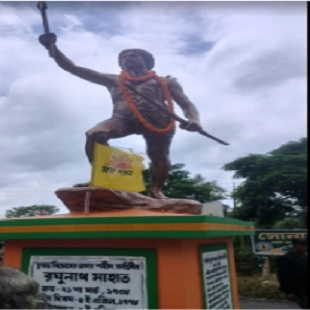Raghunath Mahato was born on 21 March 1738, in Ghutiyadi Thakurbari, Chotanagpur, which is currently situated in Nimdih Block, Chandil Subdivision Seriakela Kharsawan District of the Jharkhand state. His father, Kashinath Mahato, was a Kurmi Sardar, while his mother, Karami Mahato, was an ordinary housewife. In response to the non-payment of taxes and the tyranny of the British, he initiated a revolt and established an armed guerrilla revolutionary group. His rallying cry was ''Apna Gaon Apna Raj, Dur Hatao British Raj'' (Our Village, Our Rule, Remove the British Rule). He received invaluable support from figures such as PulkaMajhi, Domon Bhumij, and Shankar Majhi in his fight against the British.
Under his leadership, Raghunath Mahato’s armed forces successfully razed the Nimdhul fort of the British army, forcing the British to retreat to Narayansingh Garh, terrified of Raghunath Mahato's might. Consequently, Raghunath Mahato managed to capture several British army camps and establish an area free from British rule.
In 1774, Jhagaru Majhi and his cohorts managed to seize control of Kingchug Pargana, liberating the people from the oppressive grip of the British. However, on 5 April 1778, Sidney Smith, the commander of the Bengal Regiment, launched a large-scale expedition to capture them. Tragically, during a surprise attack on the Dalmar Hills, Raghunath Mahato was fatally shot. His last words, as he fell in the heat of battle, were, "Hamar Marke Pareo Larai Chalai Jabe He" (Even after my death, the struggle will continue).

Statue located at Raghunath Mahato Chowk, Bankura.
Source: Sujatak Kumar, Contributor for CCRT